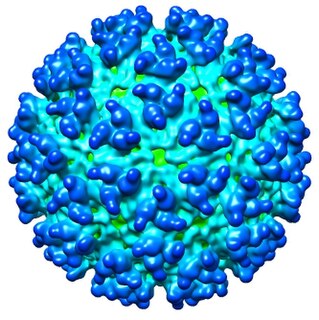Encephalomyelitis is inflammation of the brain and spinal cord. Various types of encephalomyelitis include:
La Crosse encephalitis is an encephalitis caused by an arbovirus which has a mosquito vector.
Togaviridae is a family of viruses. Humans, mammals, birds, and mosquitoes serve as natural hosts. There are currently 32 species in this family, divided among 2 genera. Diseases associated with this family include: Alphaviruses: arthritis, encephalitis; Rubiviruses: rubella.
Eastern equine encephalitis (EEE), commonly called Triple E or, sleeping sickness is a zoonotic alphavirus and arbovirus present in North, Central, and South America and the Caribbean. EEE was first recognized in Massachusetts, United States, in 1831 when 75 horses died mysteriously of viral encephalitis. Epizootics in horses have continued to occur regularly in the United States. It can also be identified in asses and zebras. Due to the rarity of the disease, its occurrence can cause economic impact in relation to the loss of horses and poultry. EEE is found today in the eastern part of the United States and is often associated with coastal plains. It can most commonly be found in East and Gulf coast states. In Florida, about one to two human cases are reported a year, although over 60 cases of equine encephalitis are reported. Some years in which conditions are favorable for the disease, the number of equine cases is over 200. Diagnosing equine encephalitis is challenging because many of the symptoms are shared with other illnesses and patients can be asymptomatic. Confirmations may require a sample of cerebral spinal fluid or brain tissue, although CT scans and MRI scans are used to detect encephalitis. This could be an indication that the need to test for EEE is necessary. If a biopsy of the cerebral spinal fluid is taken, it is sent to a specialized laboratory for testing.

In biology and immunology, an Alphavirus belongs to group IV of the Baltimore classification of the Togaviridae family of viruses, according to the system of classification based on viral genome composition introduced by David Baltimore in 1971. Alphaviruses, like all other group IV viruses, have a positive sense, single-stranded RNA genome. There are thirty alphaviruses able to infect various vertebrates such as humans, rodents, fish, birds, and larger mammals such as horses as well as invertebrates. Transmission between species and individuals occurs mainly via mosquitoes, making the alphaviruses a member of the collection of arboviruses – or arthropod-borne viruses. Alphavirus particles are enveloped, have a 70 nm diameter, tend to be spherical, and have a 40 nm isometric nucleocapsid.
California encephalitis orthobunyavirus or California encephalitis virus was discovered in Kern County, California and causes encephalitis in humans. Encephalitis is an acute inflammation of the brain that can cause minor symptoms, such as headaches, to more severe symptoms such as seizures. Mosquitoes serve as its carrier and for this reason this virus is known as an arbovirus.
Under United States law, "Biological Select Agents or Toxins" (BSATs) — or simply select agents for short — are bio-agents which since 1997 have been declared by the U.S. Department of Health and Human Services (HHS) or by the U.S. Department of Agriculture (USDA) to have the "potential to pose a severe threat to public health and safety". The agents are divided into (1) HHS select agents and toxins affecting humans; (2) USDA select agents and toxins affecting agriculture; and (3) overlap select agents and toxins affecting both.
An emerging infectious disease (EID) is an infectious disease whose incidence has increased in the past 20 years and could increase in the near future. Emerging infections account for at least 12% of all human pathogens. EIDs are caused by newly identified species or strains that may have evolved from a known infection or spread to a new population or to an area undergoing ecologic transformation, or be reemerging infections, like drug resistant tuberculosis. Nosocomial (hospital-acquired) infections, such as methicillin-resistant Staphylococcus aureus are emerging in hospitals, and extremely problematic in that they are resistant to many antibiotics. Of growing concern are adverse synergistic interactions between emerging diseases and other infectious and non-infectious conditions leading to the development of novel syndemics. Many emerging diseases are zoonotic - an animal reservoir incubates the organism, with only occasional transmission into human populations.
A neurotropic virus is a virus that is capable of infecting nerve cells.
The Central Nervous System controls most of the functions of the body and mind. It comprises the brain, spinal cord and the nerve fibers that branch off to all parts of the body. The Central Nervous System viral diseases are caused by viruses that attack the CNS. Existing and emerging viral CNS infections are major sources of human morbidity and mortality. Virus infections usually begin in the peripheral tissues, and can invade the mammalian system by spreading into the peripheral nervous system and more rarely the CNS. CNS is protected by effective immune responses and multi-layer barriers, but some viruses enter with high-efficiency through the bloodstream and some by directly infecting the nerves that innervate the tissues. Most viruses that enter can be opportunistic and accidental pathogens, but some like herpes viruses and rabies virus have evolved in time to enter the nervous system efficiently, by exploiting the neuronal cell biology. While acute viral diseases come on quickly, chronic viral conditions have long incubation periods inside the body. Their symptoms develop slowly and follow a progressive, fatal course.

Ochlerotatus is a genus of mosquito - until 2000 was ranked as a subgenus of Aedes, but after Reinert work, this clade was upgraded at a generic level. Though this change causes virtually the re-naming of the subgenus species listed in, this and many aedini closelly related taxa are suffering an ongoing revision of its taxonomy and some authors still uses "old" names in scientific publications.
The Highlands J (HJ) virus is a zoonotic alphavirus native to North and South America. It maintains a natural reservoir in the songbird population of freshwater swamps and is transmitted by the bite of the female Culiseta melanura mosquito.
Jamestown Canyon encephalitis is an infectious disease cause by the Jamestown Canyon virus, an orthobunyavirus of the California serogroup. It is mainly spread during the summer by different mosquito species in the United States and Canada.
Equine encephalomyelitis may refer to:
This page is based on this
Wikipedia article Text is available under the
CC BY-SA 4.0 license; additional terms may apply.
Images, videos and audio are available under their respective licenses.





